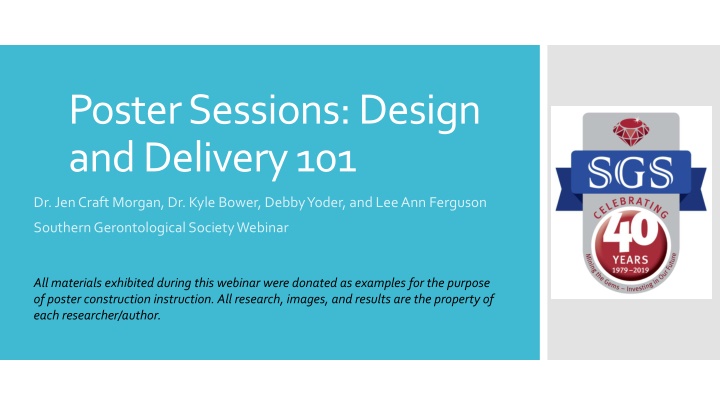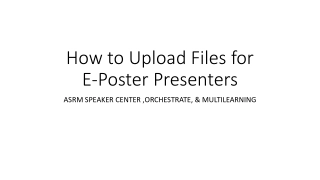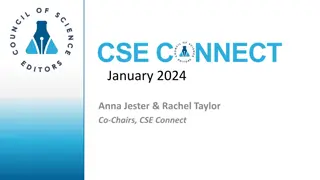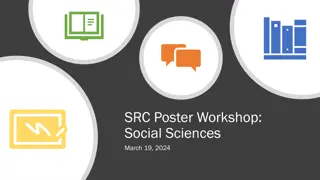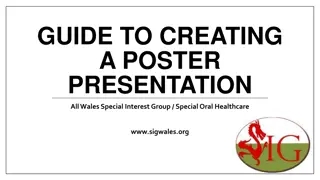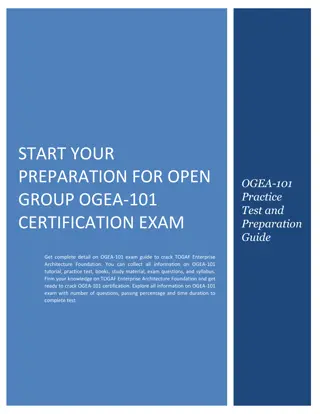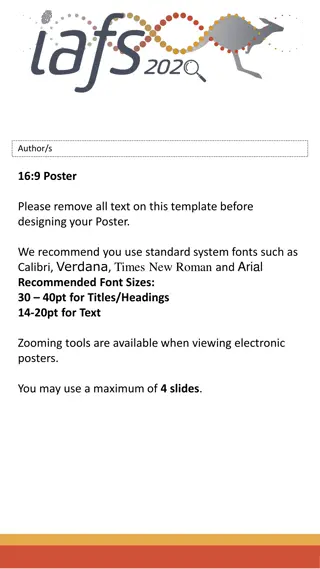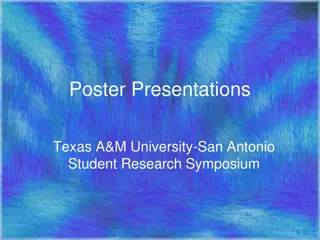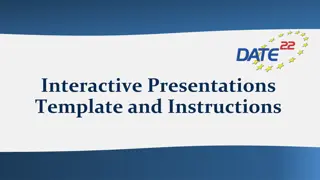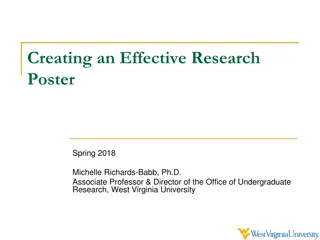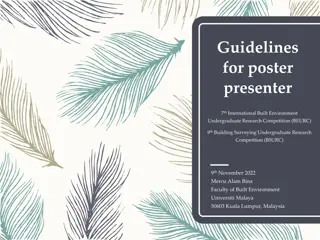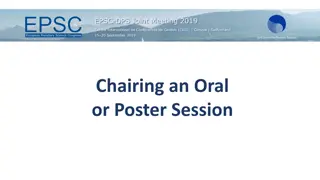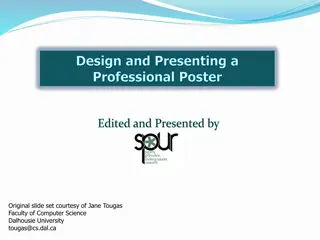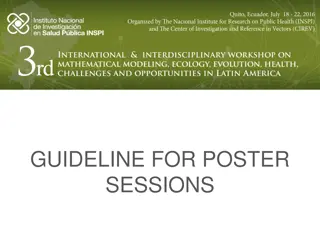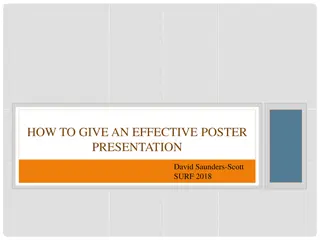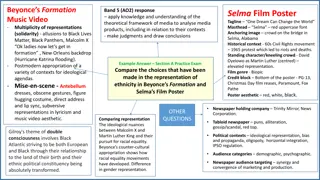Poster Sessions: Design and Delivery 101
Many disciplines use posters to share research findings effectively. Learn about poster session etiquette, preparation, and benefits for your academic or professional career. Find out how to engage with your audience, give a compelling elevator pitch, and maximize the impact of your poster presentation. Get insights on submitting abstracts, poster sizing, and student poster awards. Enhance your poster design and delivery skills with expert tips from experienced presenters.
Download Presentation

Please find below an Image/Link to download the presentation.
The content on the website is provided AS IS for your information and personal use only. It may not be sold, licensed, or shared on other websites without obtaining consent from the author.If you encounter any issues during the download, it is possible that the publisher has removed the file from their server.
You are allowed to download the files provided on this website for personal or commercial use, subject to the condition that they are used lawfully. All files are the property of their respective owners.
The content on the website is provided AS IS for your information and personal use only. It may not be sold, licensed, or shared on other websites without obtaining consent from the author.
E N D
Presentation Transcript
Poster Sessions: Design and Delivery 101 Dr. Jen Craft Morgan, Dr. Kyle Bower, Debby Yoder, and Lee Ann Ferguson Southern Gerontological Society Webinar All materials exhibited during this webinar were donated as examples for the purpose of poster construction instruction. All research, images, and results are the property of each researcher/author.
Webinar Etiquette: Please mute your audio during the presentation to diminish background noise or potential disruptions. On your Ring Central panel there is a chat feature. If you have a question, please type it into the chat box to the host and we will address it as time permits. There will be a Q&A session at the end of the presentation. This webinar is being recorded and will be published on the SGS resource website. Participation in this webinar acts as consent to be published in this webinar video.
For many disciplines, posters are the go to way to share your research findings. Posters are great for in progress work or succinctly presenting finished work to different audiences. Posters allow you to have a conversation with the audience and tailor your message to the intersection of interests. It s a great way to get feedback from a stakeholder group or from colleagues on different approaches to your findings. Posters also allow similarly interested conference attendees to find you on the program and reach out to you for potential collaboration or consultation. It s a great first presentation type for students as it is low key and flexible to multiple types of information or studies. Why present a poster?
You should be prepared to give your elevator pitch about your poster. This is basically 1-3 minutes on what your poster is about and what you found. It should help the listener understand what brought you to the topic and highlight interesting methods, results and conclusions briefly. DO NOT read the poster to listeners. What to expect during your poster session. Oftentimes, poster presenters get questions about what s next after they conclude this particular part of the study. If asked, this is a good time to provide your career/educational context, what your research/project agenda looks like and how it fits into your career plan. Remember, many of the attendees are potential future employers or collaborators. If you are a student and choose to have your poster considered for judging, you will be visited by one or more judges. They may or may not introduce themselves as such but they are usually carrying clipboard or scoring sheet. Make sure to give your full elevator speech highlighting each section of your poster.
Presenters must submit an abstract during the Call for Presentations. Check the website (www.southerngerontologicalsociety.org) for dates and directions on how to submit abstract information. Poster display boards are 48 inches tall and 96 inches wide. We encourage posters to be sized at no more than 40 inches tall and 90 inches wide. 36 by 48 size is somewhat standard and usually easiest to print. Students wanting their posters judged for the SGS student poster award need to register online for judging at: https://southerngerontologicalsociety.org/awards-student-poster.html SGS Specifics for Poster Presentations Students entering the poster award will also need to check-in with the SGS registration booth to receive a special SGS sticker that will be placed on the poster board and act as a signal for poster judges. Student posters are exhibited during the opening night of the conference, Tuesday, April 9, 2018. Please plan to be at the venue at least one hour before the poster session begins to hang your poster. Poster display boards will be marked with assignment tags. Be sure to find the board marked with your tag before hanging your poster. Do not move tags for any reason.
APA Standards & Style
Title Do not capitalize all the letters in the title Example: The girl who knows everything: A biography of Kyle Bower Helpful tip: Choose a title that captures the interest of an audience and orients the audience to the poster s content Imbedded citations Follow APA writing standards Example: (Braeburn & Gala, 2014; Smith & Fuji, 2017) Helpful tip: Make text slightly smaller than text to save space Formatting tables, graphs, charts, and pictures Follow APA writing standards Examples: see Purdue Owl, tables and figures Helpful tip: use a visual to summarize complex ideas or findings Citation list: Follow APA writing standards Example: Smith, G. & Fuji, A. (2017). The phenomenology of fall fruit. Journal of Seasonal Benefits, 1(16), 11-22. Helpful tip: Do not include every citation mentioned in the original paper, only those that appear on the poster need to be cited APA Standards & Style
Charts & Graphics Is the figure/table necessary? Is the figure/table simple, consistent, and free of extraneous detail? Are the data displayed accurately? Is the figure correctly proportioned? Proper spacing in tables? Are terms spelled correctly? Are all abbreviations and symbols explained in a figure legend or figure caption? Are they consistent in other figures? Figure 1: How to format tables and graphics using APA standards. If the table or its data are from another source, is the source properly cited? Source: Purdue Owl https://owl.purdue.edu/owl/research_and_citation/apa_ style/apa_formatting_and_style_guide/apa_tables_and _figures_1.html
Mental health services usage among Asian & Latino elders: Results from the NLAAS study James R. Muruthi, Kyle L. Bower, Denise C. Lewis University of Georgia Table 1.Descriptive characteristics of select demographic variable. Latino individuals (N = 270) N (%) 68.9 Asian individuals (N = 211) N (%) 68.70 Discussion Background & Significance Characteristics Age (mean) Results call for multi-dimensional prevention Older immigrants who migrate to the United States strategies that address mental health concerns in Sex (Female) 159 (59%) 104 (49.3%) (U.S.) report difficulty acculturating (Gonzalez, 2007) the context of immigration (Kim et al., 2011; Kim et al., 2010; Married 135 (50%) 159 (75.4%) Stressors unique to the experience of migration and Song et al., 2010) resettlement that may exacerbate or cause mental Education (<12 years) 182 (63.1%) 77 (31.3%) Specifically, results indicate a heightened need to health problems Years of residence (< 20) 54 (20%) 133 (46%) focus on prevention and treatment on mental Access mental health care at disproportionately Income (< $ 50,000) 205 (76%) 126 (60%) health disorders among aging immigrants lower rates than the general population E.g. Screen for mental health using the Geriatric Results Negative experiences may trigger mental health Depression Scale and Geriatric Anxiety Inventory Both Immigrant Populations: concerns among aging immigrants in the U.S. (Lin et al., 2016) Poor self-rated mental health, female gender, poor English language proficiency, and mental health episodes is associated with significantly greater Limitations Objectives mental health service use, even after controlling for other predictors Data were subject to reporting bias as the surveys Examine factors that influenced the usage of Asian Older Adults: used retrospective measures mental health services among Asian and Latino Use of mental health services is significantly associated with mental health Possible within-group differences were missed due older adults (50+) in the U.S episodes to grouping, based on nationality, SES, and culture Explore whether physical health ratings were Table 2.Hierarchical Regression Model. significant health need factors associated with Total Sample (N = 481) Odds ratio (95% CI) Asian Elders (N = 270) Odds ratio (95% CI) Latino Elders (N = 211) Odds ratio (95% CI) Step Predictor 1 Demographics the use of mental health services Age Female Education (<12yrs) Health insurance Married Household income 0.03 [0.97, 1.10] 1.42 [1.45, 11.68]*** 0.99 [0.94, 7.80] -0.07 [0.71, 1.22] -0.33 [0.27, 1.95] -0.14 [1.23, 14.65] -0.08 [0.08, 1.08] 0.63 [0.26, 13.51]* 1.76 [0.20, 68.75] -0.12[0.54, 4.43] -0.55 [0.03, 10.14] -1.46 [1.07, 12.86] 0.05 [0.97, 1.15] 2.24 [1.43, 61.57]*** 0.74 [0.26, 4.46] -0.06 [0.66, 1.33] -0.21 [0.20, 3.30] -1.41 [0.79, 11.12] Methods & Materials 211 Latino, 270 Asian immigrants National Latino and Asian American Survey (NLAAS) 2 Acculturation Factors Years in the U.S. ELP 3 Physical Health SR physical health Chronic condition 4 Mental Health SR mental health Mental health issue Notes: ELP = English language proficiency; SR = self-rated; dependent variable = mental health service use. *p < 0.05; **p < 0.01; ***p < 0.001. Hierarchical regression model 0.11 [0.24, 5.25] -1.47 [0.06, 0.88]** -2.51 [0.14, 2.24] -0.73 [0.1, 31.54]* 1.51 [0.30, 67.61] -2.65 [0.01, 0.55]** Demographics Acculturation factors 0.35 [0.85, 2.36]* 0.12 [0.34, 3.72] 0.85 [0.77, 7.09] 1.75 [0.31, 96.67] 0.15 [0.54, 5.90] 0.06 [0.19, 5.90] Physical health 0.35 [0.84, 2.43] 1.29 [0.96, 13.70]* 1.42 [0.84, 20.37] 43. 0.46 [0.47, 2.12] 2.75 [2.29, 60.15]** Mental health 1.23, 56.42]* Contact 1. References Kim, G., Loi, C. X. A., Chiriboga, D. A., Jang, Y., Parmelee, P., & Allen, R. S. (2011). Limited English proficiency as a barrier to mental health service use: A study of Latino and Asian immigrants with psychiatric disorders. Journal of Psychiatric Research, 45(1), 104-110. James R. Muruthi University of Georgia Email: jrmuruthi@uga.edu 2. Kim, G., Jang, Y., Chiriboga, D. A., Ma, G. X., & Schonfeld, L. (2010). Factors associated with mental health service use in Latino and Asian immigrant elders. Aging & Mental health, 14(5), 535-542. 3. Lee, S., & Matejkowski, J. (2012). Mental health service utilization among noncitizens in the United States: findings from the National Latino and Asian American Study. Administration and Policy in Mental Health and Mental Health Services Research, 39(5), 406-418. 4. Song, H. J., Han, H. R., Lee, J. E., Kim, J. Y., Kim, K. B., Ryu, J. P., & Kim, M. (2010). Does access to care still affect health care utilization by immigrants? Testing of an empirical explanatory model of health care utilization by Korean American immigrants with high blood pressure. Journal of immigrant and Minority Health, 12(4), 513-519.
Colors and Font Color Affiliation with school, organization , or cause Choose colors that compliment each other Avoid colors that are too distracting Avoid colored text, you never know who is color blind or has difficulty reading Font BASIC fonts are best Consistency with font and font styles Bolding Italics Underlined Headings need to be consistent Proper spacing of text is critical (if you have the space, USE IT!)
Photos Be sure to have model releases of anyone who is featured in a photograph. Use high quality, high resolution photos to eliminate blurriness and pixilation. If it is not a photograph you took yourself, you must cite the source of your photograph. Best practice: cite even your own photos.
Clean and Simple, Easy to Read
Details to include or omit
2017 Poster Winners Carol Jacobs Cheyann Kazemian
Pressure Ulcers Awareness and Prevention Among the Elderly Cheyann Kazemian & Jennifer Craft Morgan, PhD. Gerontology Institute, Georgia State University Pressure Ulcers Remain an Issue Next Steps and Implications Background According to the National Pressure Ulcer Advisory Panel (NPUAP), there were over 2.5 million patients that develop pressure ulcers every year. With over 60,000 deaths per year since 2012. The system is not consistent in all hospital settings. Not every hospital has the same prevention and treatment protocol for pressure ulcers. Shortage of CNAs seems to be the root of the problem. In 2011, pressure ulcers costs the U.S. Health System $9-11 billion per year, and is only increasing. - $70-150 thousand per patient - Stage III/IV. - $250,000+ per settlement. - Second most common hospital billing claim Physicians and nurses can only voice an opinion. The data now needs to be taken to administrators. With the aging population only increasing, pressure ulcers and lawsuits will increase unless proper measures are taken. Research Objective Create awareness about the impact pressure ulcers have had over the years on hospitals and patients. Creating an intervention plan for hospitals nationwide to follow a set protocol for prevention and treatment of pressure ulcers. - All starts with consistent patient movement and logging of movement. This will prevent future law suits. - Creating more and/or annual continued education courses for nurses and physicians to enforce awareness of pressure ulcers. Protocol to prevent pressure ulcers Are patients and families that have a prolonged stay in the hospital informed/educated of pressure ulcers? Are they given a brochure or information sheet of some sort? If so, what does it look like and how much detail is given? Physician: No, the patient and/or family receive no kind of information. Nurse: Yes, the patient and their family members are educated verbally, not by a brochure/information sheet. What is the protocol for nurses to make sure the patient is moving to prevent pressure ulcers? How often are they moving the patient? How are they moving the patient? Physician: N/A Nurse: Frequent turns: the patient is turned every two hours. The patient s heels and arms are elevated via pillows, and patient s are constantly checked to ensure that they are clean and dry. Is there some sort of log or time sheet for every time a patient is moved? Physician: N/A Nurse: Frequent turns are charted on ADL s. What kind of education did you get in the past about pressure ulcers? Do you take any continued education courses about pressure ulcers? Physician: Some training during fellowship. I didn t personally take any other course. Nurse: There is a wound care class that must be taken, and there is also a pressure ulcer survey that must be taken. Treatment if a patient has pressure ulcers When a patient gets a pressure ulcer during their stay at the hospital, what is the protocol of informing the patient of the occurrence? Physician: Verbally. Nurse: The nurse will let the patient know that a pressure ulcer has formed and that that specific area needs to be elevated and there will be more frequent applications of cr mes/borders and possibly more frequent turns. What information are they given now, that they didn t get before, about getting pressure ulcers? A brochure, a packet? Physician: N/A Nurse: There is no brochure or packet given, however the patient is given a more detailed description as to the steps that will be taken to heal the pressure ulcer and to prevent it from worsening. What is the protocol of treating a patient with pressure ulcers? Physician: Wound Care Team will visit daily. Nurse: Patient will continue to be turned frequently and the area of the ulcer will be elevated to prevent worsening. depending on the severity, different precautions will be taken. Baza cr me is used for initial pressure ulcers, but if the pressure ulcer is sever and deep a mepilex border will be put on the patient. What cleansing and wrapping technique is used to treat the pressure ulcer? How often? Physician: N/A Nurse: Baza cr me and mepilex borders are used. Make physicians and nurses more aware of the importance of treating pressure ulcers, and the consequences it may have on the patient and hospital. Acknowledgments - Receive treatment feedback from patients. Georgia State University Gerontology Department Grady Hospital Nation Pressure Ulcer Advisory Panel Northside Hospital References Present the proper techniques, continued education courses and practices for preventing pressure ulcers. Research Strategy and Methods Padula, William. Let s Start at the Top: Getting Administrative Buy- In. National Pressure Ulcer Advisory Panel, 3 Mar. 2017, www.npuap.org/ wp-content/uploads/2017/03/Padula- William- NPUAP-13FEB17.pdf. Padula WV, Mishra MK, Makic MB, Sullivan PW (2011). Improving the Quality of Pressure Ulcer Care with Prevention: a cost- effectiveness analysis. Med Care 49(4): 385-392. Research proper/successful protocol and treatment for pressure ulcers Contact Information Cheyann Kazemian: ckazemian1@student.gsu.edu Jennifer Craft Morgan: jmorgan39@gsu.edu Ask nurses and physicians a set of questions about protocol, treatment, and methods of prevention of pressure ulcers. - Grady Hospital - Northside Hospital * Identify where improvements can be done in the hospital setting.
Poster printing options: Check with your university about inexpensive student options. Check with your Sigma Phi Omega chapter to determine if there are student discounts There are online printers (postersmith.com, spoonflower.com, etc.). Fabric posters are more expensive but they travel easily, and can be folded without damaging the posters. Traveling with your poster Shoulder strap poster tube (available on Amazon, $14-$25 in price range) Cardboard tubes are sometimes available through printer Shipping options You may choose to ship your poster directly to the conference venue but you do so at a risk. Shipping loss and misplacement by conference venue does happen. Other items to consider Supporting Materials: Have handouts of your information available Have business cards available (place on your poster board). While SGS provides tacks to post your board up, always bring extra tacks, binders clips, and/or tape to secure materials (like handouts and business cards) to the board.
Award Application Deadlines: Questions & Answers: The floor is now open Student Travel Scholarship: February 15, 2019 Student Paper Award: February 15, 2019 Student Poster Award: Be sure to indicate on your abstract submission that you would like to be considered for judging. 2019 Conference Deadlines: Call for Presentations Deadline: November 12, 2018 SGS membership is required to participate in awards and scholarships. Late Breaker Poster Session Submission Period: January 7 February 22, 2019 Recognize your mentors, best practices, excellent media, and older adult advocates! Submit an award nomination today at: https://southerngerontologicalsociety.org/awards.html
Future Webinars Upcoming Include: ATLAS.ti for Everyday with Dr. Kyle Bower Awards for Students and Mentors- How to Apply and Why it s Important Technology Help for Older Adults How Can a Professional Organization Impact My Career? Become a member of SGS and never miss any news about what's going on next! Membership has many benefits. For more details, visit: https://southerngerontologicalsociety.org/membership.html
